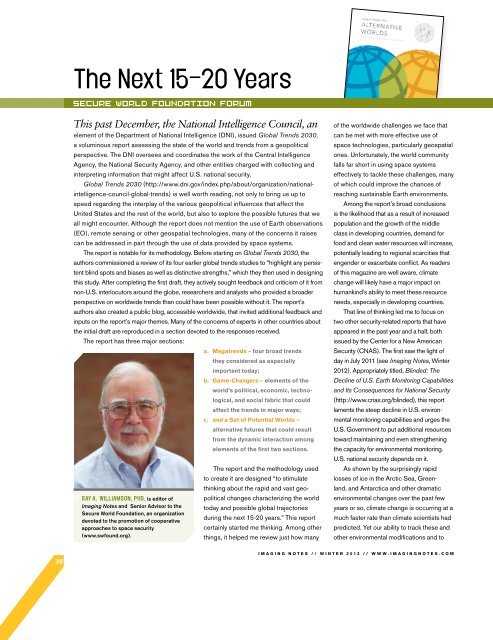download PDF - Imaging Notes
download PDF - Imaging Notes
download PDF - Imaging Notes
Create successful ePaper yourself
Turn your PDF publications into a flip-book with our unique Google optimized e-Paper software.
The Next 15–20 Years<br />
SECURE WORLD FOUNDATION FORUM<br />
This past December, the National Intelligence Council, an<br />
element of the Department of National Intelligence (DNI), issued Global Trends 2030,<br />
a voluminous report assessing the state of the world and trends from a geopolitical<br />
perspective. The DNI oversees and coordinates the work of the Central Intelligence<br />
Agency, the National Security Agency, and other entities charged with collecting and<br />
interpreting information that might affect U.S. national security.<br />
Global Trends 2030 (http://www.dni.gov/index.php/about/organization/nationalintelligence-council-global-trends)<br />
is well worth reading, not only to bring us up to<br />
speed regarding the interplay of the various geopolitical influences that affect the<br />
United States and the rest of the world, but also to explore the possible futures that we<br />
all might encounter. Although the report does not mention the use of Earth observations<br />
(EO), remote sensing or other geospatial technologies, many of the concerns it raises<br />
can be addressed in part through the use of data provided by space systems.<br />
The report is notable for its methodology. Before starting on Global Trends 2030, the<br />
authors commissioned a review of its four earlier global trends studies to “highlight any persistent<br />
blind spots and biases as well as distinctive strengths,” which they then used in designing<br />
this study. After completing the first draft, they actively sought feedback and criticism of it from<br />
non-U.S. interlocutors around the globe, researchers and analysts who provided a broader<br />
perspective on worldwide trends than could have been possible without it. The report’s<br />
authors also created a public blog, accessible worldwide, that invited additional feedback and<br />
inputs on the report’s major themes. Many of the concerns of experts in other countries about<br />
the initial draft are reproduced in a section devoted to the responses received.<br />
<br />
The report has three major sections:<br />
RAY A. WILLIAMSON, PHD, is editor of<br />
<strong>Imaging</strong> <strong>Notes</strong> and Senior Advisor to the<br />
Secure World Foundation, an organization<br />
devoted to the promotion of cooperative<br />
approaches to space security<br />
(www.swfound.org).<br />
a. Megatrends – four broad trends<br />
they considered as especially<br />
important today;<br />
b. Game-Changers – elements of the<br />
world’s political, economic, technological,<br />
and social fabric that could<br />
affect the trends in major ways;<br />
c. and a Set of Potential Worlds –<br />
alternative futures that could result<br />
from the dynamic interaction among<br />
elements of the first two sections.<br />
The report and the methodology used<br />
to create it are designed “to stimulate<br />
thinking about the rapid and vast geo-<br />
political changes characterizing the world<br />
today and possible global trajectories<br />
during the next 15-20 years.” This report<br />
certainly started me thinking. Among other<br />
things, it helped me review just how many<br />
of the worldwide challenges we face that<br />
can be met with more effective use of<br />
space technologies, particularly geospatial<br />
ones. Unfortunately, the world community<br />
falls far short in using space systems<br />
effectively to tackle these challenges, many<br />
of which could improve the chances of<br />
reaching sustainable Earth environments.<br />
Among the report’s broad conclusions<br />
is the likelihood that as a result of increased<br />
population and the growth of the middle<br />
class in developing countries, demand for<br />
food and clean water resources will increase,<br />
potentially leading to regional scarcities that<br />
engender or exacerbate conflict. As readers<br />
of this magazine are well aware, climate<br />
change will likely have a major impact on<br />
humankind’s ability to meet these resource<br />
needs, especially in developing countries.<br />
That line of thinking led me to focus on<br />
two other security-related reports that have<br />
appeared in the past year and a half, both<br />
issued by the Center for a New American<br />
Security (CNAS). The first saw the light of<br />
day in July 2011 (see <strong>Imaging</strong> <strong>Notes</strong>, Winter<br />
2012). Appropriately titled, Blinded: The<br />
Decline of U.S. Earth Monitoring Capabilities<br />
and Its Consequences for National Security<br />
(http://www.cnas.org/blinded), this report<br />
laments the steep decline in U.S. environmental<br />
monitoring capabilities and urges the<br />
U.S. Government to put additional resources<br />
toward maintaining and even strengthening<br />
the capacity for environmental monitoring.<br />
U.S. national security depends on it.<br />
As shown by the surprisingly rapid<br />
losses of ice in the Arctic Sea, Greenland,<br />
and Antarctica and other dramatic<br />
environmental changes over the past few<br />
years or so, climate change is occurring at a<br />
much faster rate than climate scientists had<br />
predicted. Yet our ability to track these and<br />
other environmental modifications and to<br />
38<br />
IMAGING NOTES // WINTER 2013 // WWW.IMAGINGNOTES.COM











